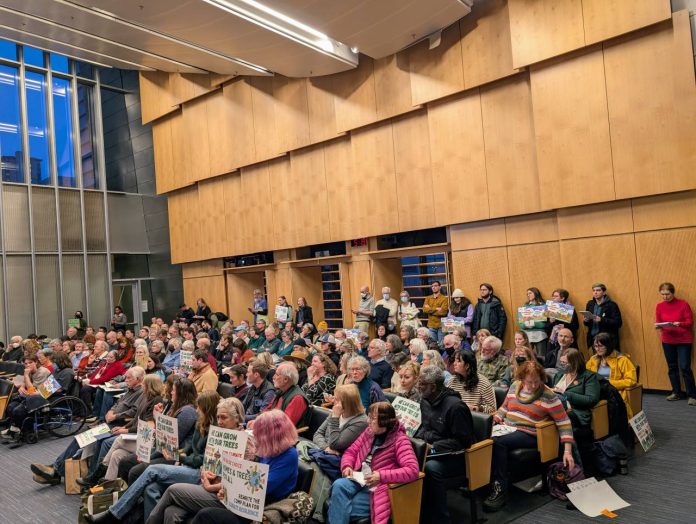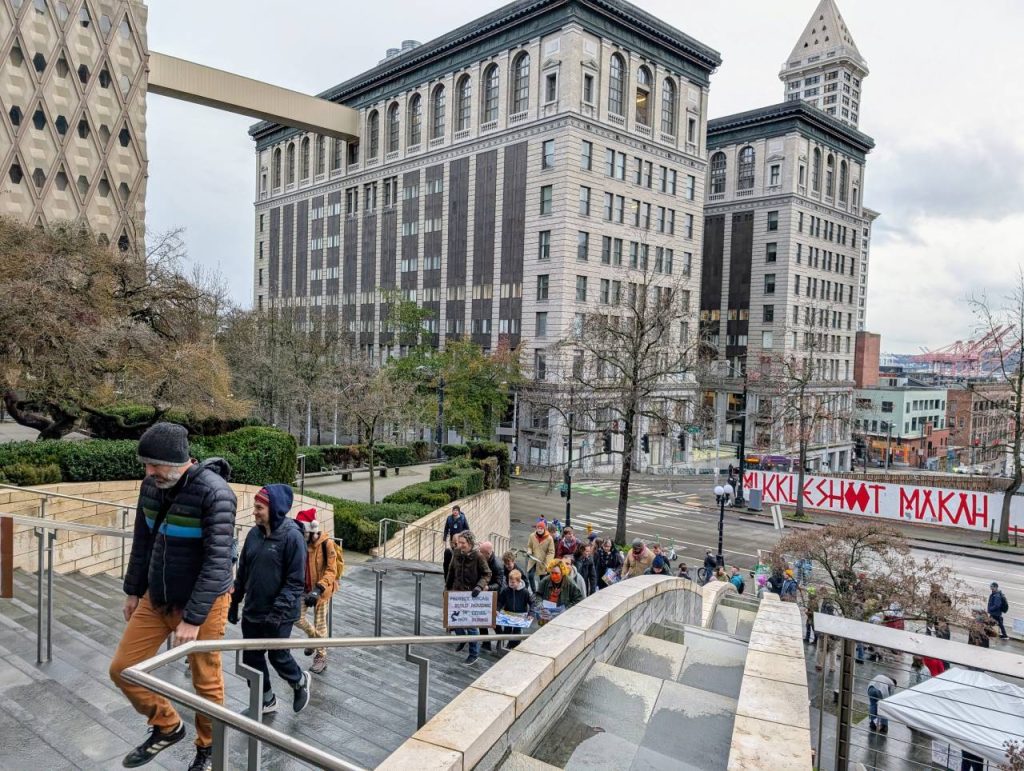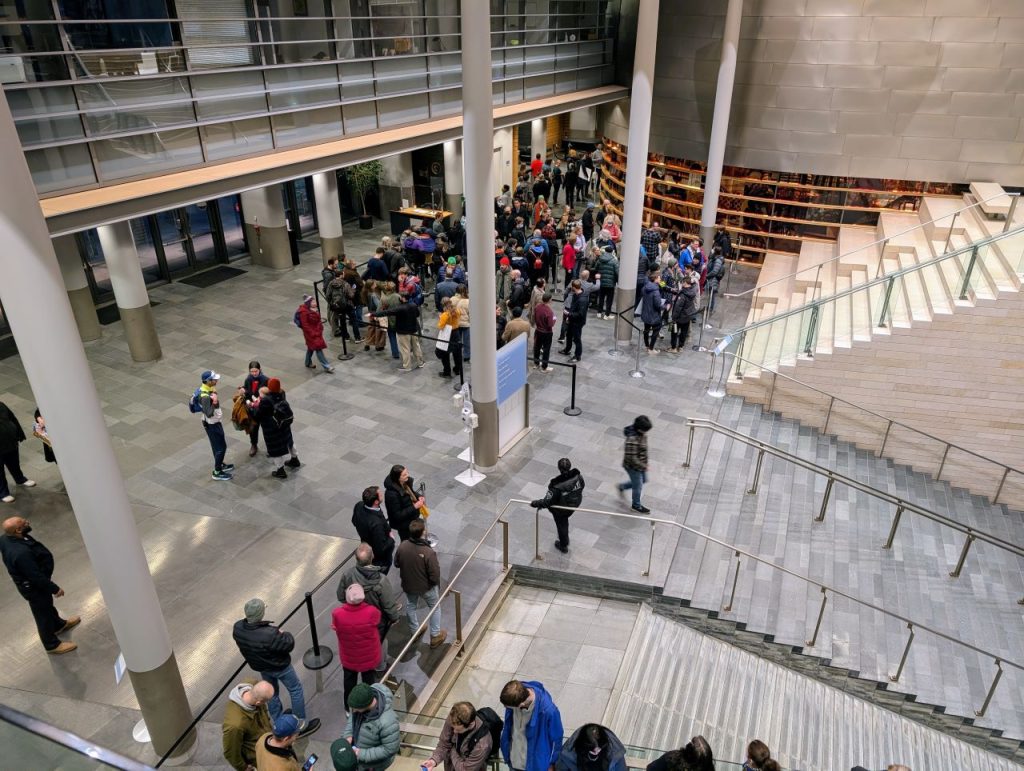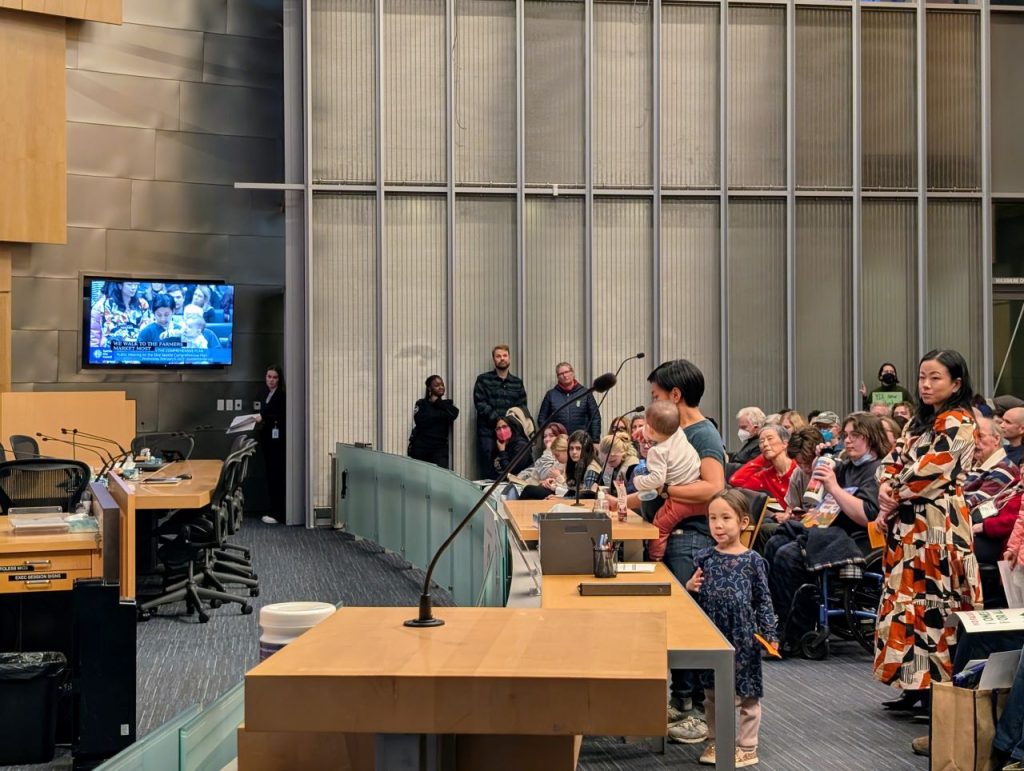
On Wednesday, the One Seattle Comprehensive Plan faced its first official public hearing since the Seattle City Council has taken on Mayor Bruce Harrell’s 20-year growth plan. Housing advocates outnumbered opponents by a margin of 89 to 75 during the five-hour-plus hearing, with dozens still waiting their turn when council called the hearing to a close due to inclement weather. Nonetheless, earlier in the day, several city councilmembers made it clear they were heeding criticisms from slow-growth advocates and change-averse homeowners, rather than the majority consensus that Seattle needs more housing options.
In the afternoon council briefing, councilmembers questioned top officials from the Office of Planning and Community Development (OPCD), with several zeroing in on their quibbles with the department’s outreach process. Councilmembers Cathy Moore (District 5), Maritza Rivera (District 4), and Rob Saka (District 1) in particular objected to how OPCD had conducted itself and claimed that a broader, more elaborate process would have assuaged critics.
In fact, Moore insinuated a silent majority was against new neighborhood center designations, which would add the potential for midrise apartment buildings and condominiums in areas stretching about 800 feet or a three-minute walk from commercial nodes shoehorned into residential neighborhoods otherwise dominated by single family housing. The mayor’s plan adds 30 neighborhood center designations, which is down from the 50 in OPCD’s earlier draft plan. Given their modest size and number, these new neighborhood centers composes just a few percent of Seattle’s land.
Moore said she was in no rush to approve any neighborhood centers, after Council deals with the immediate need to approve changes in the city’s single family neighborhoods in response to House Bill 1110, which requires fourplex or sixplex zoning at a minimum. Legislation establishing the neighborhood centers and narrow upzones along transit corridors aren’t set to come to council until mid-year. And an appeal expected to be filed by opponents could delay that timeline.
“My takeaway is that when you actually managed to get broader engagement, you actually found that there was a lot less buy-in to the plan that had been put forth,” Moore told OPCD officials. “And what troubles me is that when it became clear that there was less buy-in from the people that are going to live with this development on the ground, there’s still no willingness to truly engage and refashion this, and that that work is being put in our laps. And I don’t necessarily think that that’s appropriate. It also pits neighbor against neighbor, councilmember against councilmember. It is not a One Seattle approach, so please do a better job next time. And I do not want to be rushing through this.”
"Yes, I have a house. I'm sorry…I worked for it," Montlake resident Susan tells the crowd of people gathered at city hall to comment on the Comprehensive Plan. Susan is concerned that a "cookie cutter" approach threatens Seattle's "vibrant mosaic."
— Ryan Packer (@typewriteralley.bsky.social) February 5, 2025 at 8:56 PM
[image or embed]
Last month, Moore began pressing her argument that increasing homebuilding will not lower prices or increase housing opportunities. She reiterated that case Wednesday, saying the mayor’s proposal was hatched with developers and as crafted would be “basically opening the floodgates to this sort of unlimited development, which is not going to get us where we need to be.”
Moore and Saka suggested that OPCD conduct a citywide mailing campaign to spread word about the plan and solicit more comments. OPCD Director Rico Quirindongo said the City had looked into the idea, but it was expensive and exceeded their budgeted resources.
OPCD has already received a mountain of public feedback, including nearly 6,000 public comments when it released the draft One Seattle plan in spring 2024. However, Moore and Rivera insisted that deeper outreach was needed and that matters were not well understood at the time for commenters to fully engage with issues. The skepticism appear to stem from the pair of North Seattle councilmembers apparently not agreeing with the key takeaways OPCD identified from their public outreach process thus far.
“So what did we hear? Again, this is in spring of 2024 in response to the draft plan. Well, first, with regard to the growth strategy, we heard general strong support for more housing, and the plan providing for more housing across the city, more diverse housing choices in all neighborhoods, more housing density near transit, and the concept of housing in more complete neighborhoods, with housing near shops, services, and amenities — that 15 minute city idea,” OPCD Long Range Planning Manager Michael Hubner told councilmembers.

Furthermore, this rezone-resistant faction on Council contended that deeper outreach would allow a plan with broad appeal across the board to emerge, making Council’s job in amending and adopting the plan easy.
“If you had done the public engagement, truly public engagement to residents broadly early on, you would have seen some that a lot of people actually would have been in support of a plan that was really a ‘One Seattle’ approach,” Rivera said. “Because if they have the information early, and if they feel like they’re able to make some tweaks to the plan early, they I think you would have seen support for some of these things anyway, but it’s just people felt like it was a very backhanded way of doing it. And I never want to be in that space.”
It’s not clear where Moore and Rivera get the idea that universal support for housing reforms is possible — at least based on history. Virtually every land use reform in Seattle history has been contentious and draw the ire of a seldom-satisfied contingent of homeowner associations and neighborhood groups. Even with something as benign as allowing backyard cottages in single family zones was appealed multiple times and delayed three years in an effort led by the Queen Anne Community Council, a group to which Councilmember Bob Kettle (District 7) was formerly a member.
The idea that salt-of-the-earth homeowners were not invited to participate or informed of a zoning change has also long been a trope in Seattle housing debates, which is often transparently a self-serving notion promoted by very the homeowner groups organizing to block changes of which they’re all too aware.
Her family moved to Queen Anne in 1929. Says she wasn't informed about the public meeting where she is currently testifying on television.
— Qagggy! (@qagggy.bsky.social) February 5, 2025 at 7:24 PM
[image or embed]
While councilmembers can dream of zoning tweaks from OPCD will quell all backlash, back in reality appears Council will have to choose a side and live with the consequences, which is sure to include sharp criticism from some quarters. The side that several centrist councilmembers appear to now be inhabiting is different than what they said on the campaign trail, when nearly all backed Alternative 5 or 6, both of which goes beyond the mayor’s plan in adding apartment zoning in transit corridors and a greater number of neighborhood centers. Rivera managed not to take a firm position, but Moore, Saka, and Kettle ran as “Alternative 5 guys,” as Kettle puts it — though he has redefined what that means.
Campaigning as a not-in-my-backyard (NIMBY) slow growth activist may not have been tenable, but legislating like it appears to be on the menu. This means housing advocates have their work cut out for them, as Robert Cruickshank, a progressive operative and occasional contributor with The Urbanist, pointed out while waiting to testify Wednesday. Cruickshank has been organizing pro-housing advocates and helped put together the “One Seattle For All” website.
“The NIMBYs are pushing on a bit of an open door there, despite what some of these councilmembers were saying on the campaign trail,” Cruickshank said. “So, what has to happen then is a whole round of education all over again that a lot of people thought was already done actually turns out, no, we still have to do that work. And that became very clear at that Council meeting on January 6, and every council meeting since then where this has come up, it’s just been reinforced that a lot of these councilmembers have crazy ideas about housing that don’t make sense and don’t match what is in the real world and don’t match the public opinion of the city. But until we mobilize public opinion, the NIMBY voice will continue to prevail.”
On the flip side of the issue, Councilmember Alexis Mercedes Rinck, who represents a citywide seat and is running for reelection in the fall, pressed OPCD on the planning justification for parking mandates. She also asked the justification for not allowing corner stores and neighborhood cafes more broadly and for not expanding housing options to a greater degree after most public comment fell in favor last year. Running on a stridently pro-housing platform with The Urbanist’s endorsement, Rinck handily won election in November.
“There’s a note on slide 22 that in addition to concerns that have been arisen, there still were calls to zone for more housing in more areas,” Rinck said. “But ultimately, we saw little change between the second draft and the draft now before us, and, in fact, some of our centers seem to have reduced slightly in scale. So, could you explain how comments on the second draft, with respect to considering the number, size and location of regional, urban and neighborhood centers were incorporated into the final proposal before us?”


Hubner granted that the drafts have been pretty similar throughout the process, but did point to the additional five neighborhood centers added in the fall as responding to pro-housing feedback. He said expanding corner store opportunities could be possible in final zoning proposals.
Of course, housing advocates are hoping to win even more neighborhood centers and broader transit corridor rezones than the meager one-minute walksheds on the immediate blocks of transit corridors in the mayor’s plan. The Seattle Planning Commission — the official body tasked with advising the city on planning and land use matters — has echoed that sentiment.
One commenter wants more housing. Another wants less. Can you guess which is which?
— Qagggy! (@qagggy.bsky.social) February 5, 2025 at 8:24 PM
[image or embed]
A generational divide was clearly on display at Wednesday’s public hearing. Opponents tended to be older homeowners, while housing proponents tended to be younger and renters. Of course, exceptions existed on both sides. Still, the general direction of who believed they’d lose out if Seattle does not zone for more housing and increase homebuilding was stark, even as both sides jousted for the moral high ground. The gatekeepers pulling up the drawbridge on struggling neighbors and future generations of homeowners may be shocked to find they will not be greeted as heroes.
Doug Trumm is publisher of The Urbanist. An Urbanist writer since 2015, he dreams of pedestrian streets, bus lanes, and a mass-timber building spree to end our housing crisis. He graduated from the Evans School of Public Policy and Governance at the University of Washington in 2019. He lives in Seattle's Fremont neighborhood and loves to explore the city by foot and by bike.



